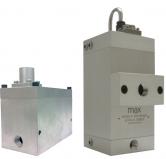Recirculating Fuel and Efficient Bubble Elimination Increases Fuel Measurement Accuracy
In an attempt to measure actual fuel consumption, early designs of fuel measurement systems employed two flow meters; one would measure supply fuel and the other, return fuel. By subtracting the return fuel from the fuel supplied, a consumption rate was derived. This technique is subject to large errors—especially during idle or lower rpm settings.
Example, using two flow meters, each with nominal 0.5% measurement error, a supply rate of 100 lb/hr and a return rate of 90 lb/hr produces a potential error of 0.5 lb/hr and 0.45 lb/hr respectively. Combined, these become a potential error of 9.5% when compared to the actual 10 lb/hr consumed.
Max recommends a fuel measurement system that avoids these errors by recirculating the return fuel into a Series 370 Level Controller before returning it to the engine.

